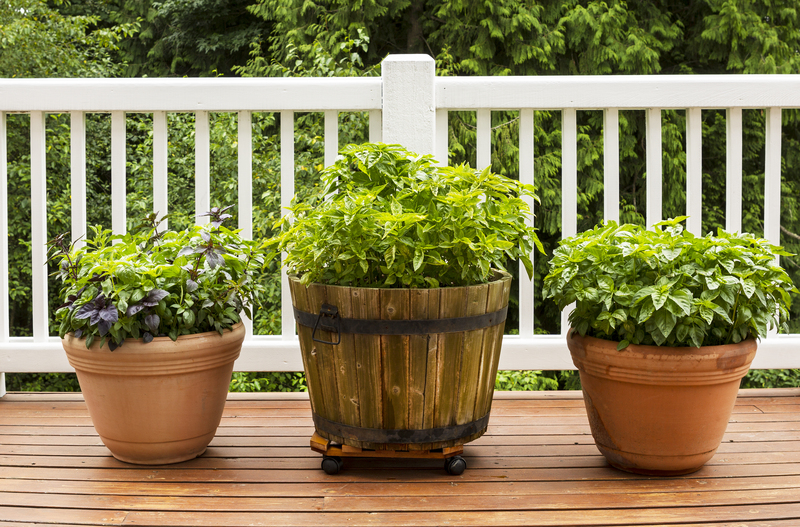Winter Care for Your Garden: Simple Protection Hacks
Posted on 12/06/2025
Winter Care for Your Garden: Simple Protection Hacks
As the chilly months roll in, garden enthusiasts often wonder how to best protect their gardens during winter. Without the right approach, winter's harsh conditions can impact plants, soil, and overall garden health. This comprehensive guide provides actionable hacks and strategies for winter garden care to help your outdoor space not only survive but also thrive until spring. Discover practical methods to shield your precious plants and beds from frost, snow, and freezing temperatures.
Why Winter Garden Protection Matters
Many gardeners underestimate the significance of winter care for gardens. The cold season brings temperature swings, heavy frost, damaging winds, and moisture loss, which can all pose serious risks. Some plants go dormant, while others fight to survive extreme conditions. Proper preparation and tailored protection hacks ensure that both your plants and soil remain healthy, maximizing your garden's productivity in the coming year.
Common Winter Challenges for Gardens
- Freezing and Thawing: Causes soil to heave, damaging roots.
- Heavy Frost: Kills sensitive or non-hardy plants.
- Snow Accumulation: Breaks branches and compacts soil.
- Wind Damage: Dries out evergreens and soil.
- Lack of Moisture: Roots can desiccate, especially in newly planted beds.
- Pest and Disease Persistence: Some pests overwinter in debris and can attack in spring.

Preparing Your Garden for Winter: Essential Steps
1. Clean Up and Cut Back
Before the first frost, clear away dead plant material, fallen leaves, and diseased stems. This prevents pests and fungi from overwintering in your beds. However, leave healthy perennials and some seed heads for winter interest and wildlife support. A tidy garden is the foundation of successful winter protection.
2. Mulching: Nature's Blanket for Cold Protection
A thick layer of mulch insulates plant roots and stabilizes soil temperature, reducing the risk of root damage from freeze-thaw cycles. Choose organic mulches like straw, wood chips, shredded leaves, or compost.
- Apply mulch 2-4 inches thick around perennials, roses, and newly planted shrubs.
- Keep mulch a few inches away from woody stems to avoid rot.
- For vegetable beds, mulch helps prevent soil erosion and preserves nutrients.
Mulching is a must-do hack for winter garden care--it's simple, economical, and highly effective.
3. Watering: Prevent Dehydration During Winter
Although plants aren't actively growing, hydrated roots are less susceptible to cold injury. Water deeply before the ground freezes, especially for evergreens and new plantings. Don't forget about containers; they dry out faster than in-ground beds.
4. Protecting Sensitive Plants and Trees
Some plants need extra help to withstand winter. Wrap sensitive shrubs (like hydrangeas or young fruit trees) with burlap or frost cloth to shield them from icy winds and fluctuating temperatures.
- For roses: Mound mulch or compost around the base for insulation.
- Tender bulbs: Dig up and store indoors if they're not winter hardy in your climate.
- Containers: Move pots into sheltered areas or group together and wrap with bubble wrap for additional insulation.
Winter Hacks for Lawn and Soil Protection
1. Care for Your Lawn During Dormancy
Lawns need attention before winter sets in. Give your grass a final mow, aerate compacted areas, and remove heavy layers of leaves. This prevents mold and encourages stronger roots.
2. Winter Cover Crops
Planting winter cover crops, such as clover, rye, or winter peas, boosts soil fertility and prevents erosion. Cover crops add nutrients and organic matter, making them an excellent solution for eco-friendly gardeners.
3. Soil Testing and Amendment
Winter downtime is perfect for testing your soil. Amend your beds with compost or slow-release organic fertilizers. By spring, the nutrients will be well incorporated, setting your plants up for rapid growth.
Tips to Shield Perennials, Trees, and Shrubs
1. Perennial Protection: The Blanket Method
- After the ground freezes, add 4-6 inches of mulch around perennial crowns for extra warmth.
- Leave coneflower and black-eyed Susan seed heads as a winter food source for birds.
- Cut back spent foliage only where disease is present; otherwise, let it protect the plant base naturally.
2. Shrub and Tree Wrapping
- Use burlap, tree wrap, or frost blankets for newly planted or tender shrubs and trees.
- For evergreens, set up windbreaks from stakes and burlap on the prevailing wind side.
- Water evergreens well until the ground freezes to reduce winter desiccation.
3. Anti-Desiccant Sprays
Use anti-desiccant sprays on broadleaf evergreens and conifers to reduce moisture loss during harsh winter winds.
Safeguarding Your Vegetable Garden in Winter
1. Extend the Harvest with Cold Frames and Row Covers
- Cold frames and cloches create a microclimate for leafy greens and root crops.
- Row covers, made of spun-bonded fabric, keep frost off vegetables and allow light and water through.
- Harvest hardy crops: Kale, Brussels sprouts, carrots, and parsnips can often be picked through winter.
2. Mark and Mulch Over-Wintering Crops
- Mark rows of overwintering veggies (like garlic and onions) to avoid disturbing them.
- Mulch beds with straw or leaves for insulation and weed suppression.
3. Tool and Bed Maintenance
- Store garden tools under cover, cleaned and lightly oiled.
- Remove and compost spent plants to minimize disease carryover.
Protecting Container Gardens from the Cold
1. Move Pots to Sheltered Areas
Relocate containers to the lee of buildings, under porches, or inside garages to minimize exposure to freezing temperatures.
2. Insulate and Group Containers
- Wrap pots with bubble wrap, hessian, or garden fleece.
- Group containers together to share warmth and block wind.
- Raise pots off the ground using pot feet or bricks, ensuring drainage and reducing the risk of water-logging or freezing.
3. Select Hardy Plants for Winter Pots
Opt for dwarf evergreens, ornamental grasses, or pansies for seasonal color and resilience.
Protecting Wildlife While Caring for Your Garden
Good winter garden care also means supporting local wildlife. Birds, pollinators, and beneficial insects rely on your garden for food and shelter.
- Leave some seed heads and leaf litter for wildlife habitat.
- Provide fresh water sources that won't freeze quickly.
- Add bird feeders and nest boxes to compensate for food shortages.
These small actions help ecosystem balance and make your wintertime garden vibrant with life.
Pest and Disease Management in Winter
1. Winter Clean-Up Tasks
- Remove diseased material and dispose of it safely, not in compost.
- Clean out greenhouses and cold frames to prevent pest build-up.
- Inspect plants regularly for overwintering eggs or larvae.
2. Use Organic Barriers
- Surround vulnerable plant bases with copper tape or crushed eggshells to deter slugs and snails waking in early spring.
- Install physical barriers to keep rodents from burrowing into mulch beds or stored produce.
Indoor Gardening in Winter: Nurturing Your Green Companions
Not all gardening pauses during winter. Bring tender plants indoors, especially tropicals and potted herbs. Place near sunny windows and monitor for pests. Winter is the perfect opportunity to propagate houseplants or start seeds early for spring.
Planning Ahead: Turn Winter into Next Year's Growth Opportunity
Use winter's lull to plan your future garden updates. Research new plants, sketch layouts, and order seeds early for the best selection.
- Reflect on what performed well last year and what could improve.
- Clean and sharpen tools or upgrade equipment as needed.
- Enroll in gardening workshops or courses to build your skills.

Frequently Asked Questions: Winter Garden Protection
How can I tell if my plants need extra winter protection?
Check plant tags or consult gardening references for cold hardiness. New plantings, non-native species, and tender perennials generally need more insulation than established, hardy varieties.
How early should I start preparing my garden for winter?
Begin after temperatures begin to cool and before the first hard frost. This gives you time to mulch, water, and move containers or plants.
What is the best mulch for winter protection?
Organic options like straw, shredded leaves, or bark chips are ideal--they insulate well and improve the soil as they break down.
Conclusion: The Rewards of Smart Winter Garden Care
With these winter garden care hacks, you'll safeguard your landscape, nurture biodiversity, and ensure a vibrant, healthy garden when spring returns. Whether you're mulching, wrapping, watering, or simply planning ahead, your proactive care makes all the difference. Embrace winter as a time to protect, observe, and prepare--your garden (and its wildlife visitors) will thank you!
Taking the time to protect your garden in winter is an investment in its long-term beauty and productivity. Try these simple yet effective hacks, and enjoy the peace of mind that comes with knowing your green space is ready for anything the season brings.



